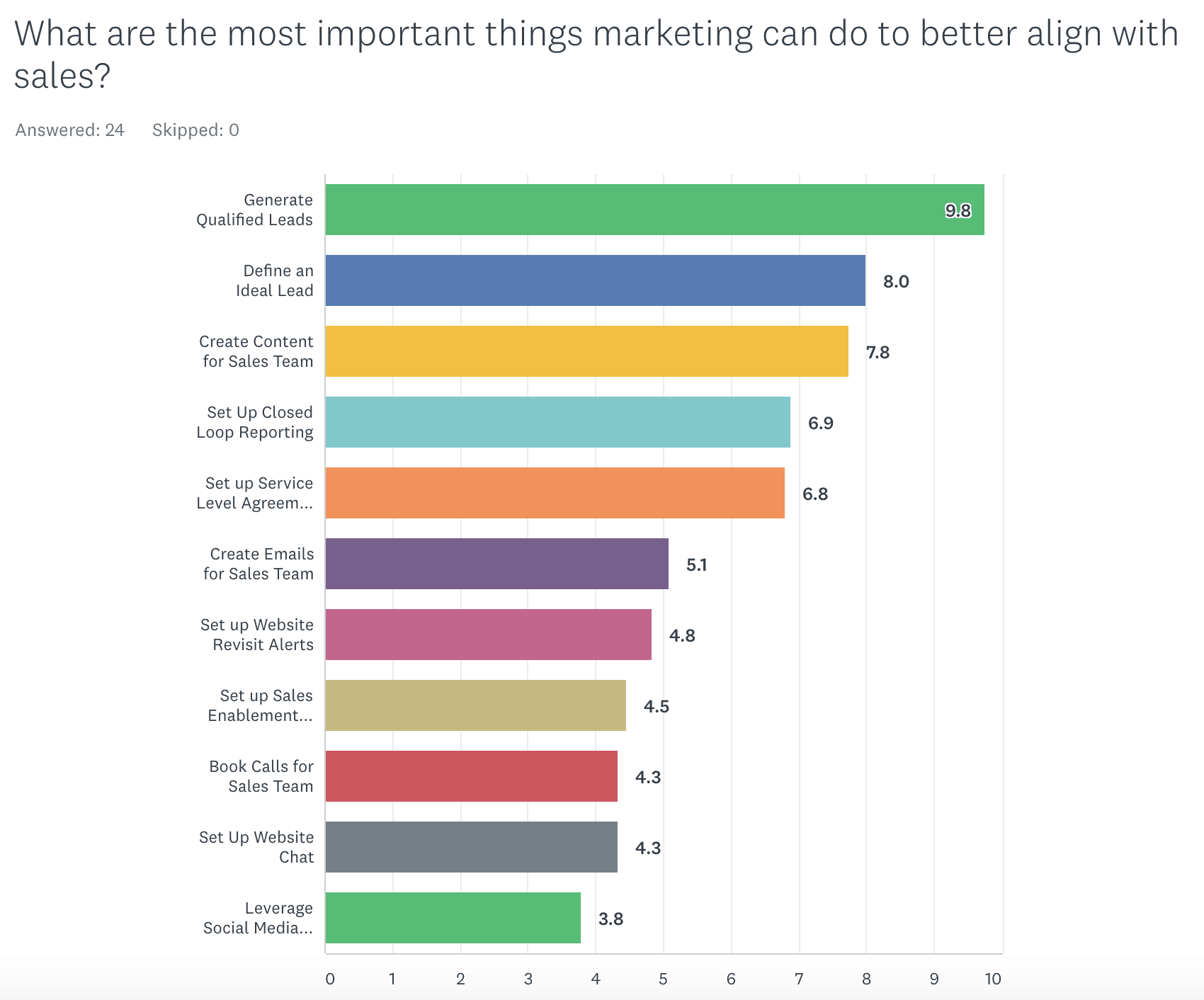Get WISER with Your AI Prompts - A guide for sales managers
Everyone’s wittering on about AI like it’s the second coming. But here’s the rub: if you give it half-baked prompts, you’ll get half-baked answers....
6 min read
 Chris Fell
03/05/2018 1:00:00 PM
Chris Fell
03/05/2018 1:00:00 PM


This article was originally posted on the databox blog.
In HubSpot’s State of Inbound 2017 report, 6000 respondents were polled on the current state of alignment between marketing and sales teams.As you can see in the graph below, there seems to be significant disagreement on whether companies are successfully connecting two teams.

While 31% of C-level executives feel that their marketing and sales teams are tightly aligned, only 17% of managers and individual contributors feel the same way. And, considering those are the employees that need to deal with alignment on a daily basis, executives may be overrating the effectiveness of communication within their organisation.
So, we polled our community of inbound marketers to learn what specific tactics will guarantee that sales and marketing are on the same page. If you are not using any of these tactics at your own company, the goals of the two teams are probably not as aligned as you think they are.
By employing some of these tips, you have a great opportunity to get more revenue out of your existing team, and make everyone’s lives a little easier along the way. Here are a few tactics that will help.

It’s one thing to have sales and marketing sit in a meeting together and agree on the best way to hand off leads. But it is a whole separate challenge to make the handoff within the software you use. If your marketing automation system and CRM originate from the same software provider, like HubSpot, your life gets a little easier.
But, you still need to set up automation workflows and emails at the right time. The new flood of information should be helpful rather than overwhelming.
 Jen Spencer
Jen Spencer
SmartBug Media
Tactic: Even though I believed I was sharing all marketing activities with the sales team — we were all part of the same department, in fact — with so much information flowing regularly, it was overwhelming for the SDRs.
One very simple adjustment we made was that when we planned to launch a new premium asset (ebook, checklist, guide, etc), the SDR team blocked out 30-40 minutes on their calendars at the time of launch. Using HubSpot’s sales enablement tools, the SDRs could watch their prospects engage with the content in real-time. They placed calls to their sales-ready prospects and were able to improve their connection and meeting booking rates because of their timing.
 Parker Short
Parker Short
Jaxzen Marketing Strategies
Tactic: We set up a lead handoff workflow. We also spend a fair amount of time customizing the lead assignment notification email to make sure that it’s very actionable. Salespeople don’t want a ton of extra emails, so we focus on surfacing what’s the most important about that lead when they’re handed off. We’ll combine this with some recommended next steps and some content to share if it’s applicable.

Rather than give a lecture to your sales team on the merits of your inbound marketing investments, you can instead demonstrate its value by getting members of the sales and marketing team to work on a content project together.
By creating landing pages or bottom-of-funnel content together, marketers and salespeople can learn more about the challenges their prospects face, and deliver a quick win for the two teams.
 Jeff Coon
Jeff Coon
Stream Creative
Tactic: Create interactive and personalised sales pages. The marketing team knows how powerful their website can be in the sales process, and the sales team understands and lives in the world of proposals. By getting sales and marketing together to map out a strategy on how, when and where to use these interactive sales pages, it fosters great discussion around a concept that both teams are familiar with (a proposal.)
We’ve found that this tangible asset (the sales page) creates a sense of focus and clarity around a common goal — When we talk about giving them a competitive advantage and building trust and a personal connection with their prospects, they are definitely more attentive.
 Brittany Laeger
Brittany Laeger
StoryTeller Media + Communications
Tactic: Content is one of the most under-utilised tools to improve sales and marketing alignment. Content can be an immensely useful and non-invasive way for salespeople to reach out to prospects and potential customers.
The sales team should be one of marketing’s biggest assets when it comes to creating content that will help bring people closer to a purchasing decision. Start by answering the most common questions that your sales team answers and help them build up an arsenal of great content they can use in the sales process.

Although marketers and salespeople may aspire to build their relationship “one day,” you can accelerate the process by setting up a weekly meeting, even if it unstructured to begin with…
 Mike Schutz
Mike Schutz
RAIN Group
Tactic: Marketing and sales leadership should spend shared, unstructured time together. An hour meeting with no agenda except to ‘talk strategy’ or have lunch. They should ask each other questions about their goals, philosophies, and initiatives.
Nothing is better than spending time together for gaining understanding and building trust, two critical preconditions of marketing and sales alignment.
 Evan Ebert
Evan Ebert
Fannit
Tactic: Having a weekly or bi-weekly comprehensive meeting between marketing and sales is important.
However, you also need to have somebody in the organization who can ask the right questions and run the meeting. Most companies and teams have very insightful contributors…but not everybody is willing to step up to the plate and share, unless prompted. Find people who are:
1. Good at keeping order
2. Effective at communicating with all personality types
3. Can bring out the best in each teammate
 Rob Steffens
Rob Steffens
Bluleadz
Tactic: Instead of having 2 separate weekly Sales and Marketing meetings, we have combined them. We have 1 weekly “Smarketing” meeting. From there, we are constantly able to walk away with new ideas.
After one of these meetings, both sides agreed to have marketing sit in silently on some sales calls. This gave the marketing team a better understanding of their personas and their current pains/questions. We were able to create content around those questions, so these specific customer personas have the information they desire at their fingertips.
 Paulo Henrique Lemos
Paulo Henrique Lemos
Hook Digital
Tactic: Build an integrated marketing and sales funnel and have both teams agree on the stages, the metrics and the actions that each one is responsible for. Then spend at least 20-30 minutes every week reviewing progress and making decisions about where and how to improve each metric.
 Eric Quanstrom
Eric Quanstrom
CIENCE Technologies
Tactic: Have the marketing team members present as observers in the different part of the sales process on at least a quarterly basis. This can include Discovery calls, Demo’s, Negotiations, or other defined steps in the sales process. The benefit here is firsthand knowledge.

If marketing is evaluated on traffic and leads generated, while the sales team is evaluated on the number of deals closed and revenue generation, then you shouldn’t be surprised when the two sides never talk!
There must be some sort of shared goal in order to encourage collaboration.
 Nicole Mertes
Nicole Mertes
Weidert Group
Tactic: Set up a Service Level Agreement (SLA) between Sales and Marketing. Alignment starts with a discussion on the role each department plays to reach the common goal.
 Greg Linnemanstons
Greg Linnemanstons
Weidert Group
Tactic: Transparency and visibility around goals, expectations, and results between marketing and sales, to build a 360-degree culture of accountability. Those things that you measure and report on get attention, from lead attraction to client retention measures.
 Sara Larsen
Sara Larsen
Doidea
Tactic: Unite around joint KPIs. The only way to ensure both departments strive towards the same end goal, is to share the same end goal.
 Chris Handy
Chris Handy
ClosedWon
Tactic: Start with a list of target accounts and discuss how you plan to reach them as a group. This then dictates the strategy for the entire team. Suddenly the sales team will actually share content on social media when they understand the content was written for their target account. Suddenly, everything starts to become more clear and the tools you use, like live messaging, start to get cross-company adoption when marketing knows the leads that sales wants to chat with.

After your sales and marketing teams start talking about the concerns and challenges commonly shared by prospects, a number of opportunities open up. First, salespeople can advise whether the top of funnel content really addresses the challenges of the ideal buyer persona. Second, marketers can learn about bottom-of-funnel content opportunities that will help salespeople accelerate the sales process.
 Dani Buckley
Dani Buckley
LeadG2
Tactic: Create shared target persona profiles, ideal customer profiles, and lead definitions so that both marketing and sales team members know exactly who they’re targeting and understand how to properly communicate and reach them.
 Chris Fell
Chris Fell
g2m Solutions
Tactic: Don’t align around your internal definitions of your funnel stages like MQL, or prospect, but instead align on the buyer’s or customer’s decision stages. For example, interest expressed, needs agreed, preference formed, decision made and so on. Honour the buyer’s thinking process, not your selling process. Build your data model and KPIs around these customer definitions and you will be aligned.
The experts suggested (at least) 10 different tactics you can try to create a bigger connection between marketing and sales. So, we asked them which ones should be the highest priority.

The best way for sales to work with marketing is to follow up with the leads that marketing has captured.
Okay, that one isn’t too much of a surprise. But, the second most popular suggestion, feedback on lead quality, at least shows that each team should take some ownership of lead quality. Salespeople are accustomed to complaining about poor quality leads from marketing, and marketers complain that salespeople never call their leads. Having regular conversations about lead quality, though, is a more constructive way of resolving this dispute.
We also asked respondents to tell us which marketing tactics are most critical for sales alignment…

Again, the top priority by consensus was generating qualified leads. But the second most popular tactic was “defining an ideal lead”, which seems to correspond to the sales team’s goal of providing feedback on the quality of leads.
Here’s the lesson I learned: If you don’t have great communication between marketing and sales on the ideal customer profile, none of the other tactics will matter very much.
If you'd like to talk about improving your sales and marketing alignment, we’re happy to have a short informal consultation about some steps you could take.
Subscribe to our latest news and updates on HubSpot.

Everyone’s wittering on about AI like it’s the second coming. But here’s the rub: if you give it half-baked prompts, you’ll get half-baked answers....

The business world is falling head over heels for AI—and who can blame it? With promises to reduce grunt work, uncover insights, and turbocharge...

Search is evolving - fast. For two decades, SEO has revolved around Google’s algorithm: keywords, backlinks, metadata, and page speed. But with the...